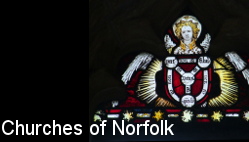
home I index I latest I glossary I introductions I e-mail I about this site
St Swithin, Bintree
Follow these journeys as they happen at Last Of England Twitter.
St Swithin, Bintree Although it is not huge, this church appears to sprawl in its tight churchyard. The church was rebuilt gradually over the course of the 14th Century, with an imposing south transept and a neat little aisle that runs between the tower and the transept. Over the next few centuries there seems to have been a succession of refurbishments and rebuildings of various parts according to the needs and fashions of the day, including a replacement chancel as a result of the old one collapsing at the end of the 18th Century. It is perhaps a surprise then that the exterior is so harmonious. The main 19th Century restoration here was in 1864, a fairly early date in Norfolk for what was a major High Church makeover. In the years that followed Bintree seems to have climbed higher into the Anglo-Catholic stratosphere, and as late as 1928 the transept was reordered as a chapel of the Blessed Virgin Mary, although that tradition appeared to have gone by the time I first visited in the early years of the present century. Mortlock recalled the fascinating detail that Bintree was the parish in the 1890s of Father Enracht, who had been the last priest imprisoned under late Victorian legislation aimed at preventing the introduction of ritual into Anglican churches. Amazingly, the processional cross still in use at Bintree at the time Mortlock was writing was the very same one that had caused all the trouble. I had long been looking forward to coming back to Bintree, not least because the east window installed at the time of the 19th Century restoration is by Alexander Gibbs, who had also been working at that time on All Saints Margaret Street in London. It depicts a Crucifixion scene with watchers looking on. A curiosity about this glass is that the great stained glass expert Birkin Haward credited it to Heaton, Butler & Bayne, considering it evidently in their style. I make no claims to being an expert, but a notable feature of the glass is its inscription along the bottom. Sometimes it takes a bit of detective work to find the maker's mark in a window, but here at Bintree Mr Gibbs signed it in a vibrant blue, telling you that he fecit ('made it') and even giving his address in case anyone fancied putting a little bit more work his way. The glass in the transept is by William Wailes. It shows Christ the Good Shepherd and Christ with the little children flanking a central Christ in Majesty. There's an early 20th Century Annunciation by Horace Wilkinson. The 14th Century font that came with the rebuilt nave is a lump of a thing, curiously inelegant and even slightly assymetrical. Up in the sanctuary is a Holy Trinity symbol. It is dated 1664, just after the end of the Commonwealth, and was presumably an attempt to reassert orthodox Trinitarian doctrine after twenty years of the world being turned upside down with all manner of Unitarian sects. However, I'm telling you all this from memory, for when I turned up in Bintree in September 2022 I found that the church is no longer in use by the parish. It has been taken into the care of the Norwich Diocesan Churches Trust, and it was locked. There was no keyholder notice, and so the interior photographs here are from visits in years gone by. I know that these are difficult times for the rural church, especially after the Covid pandemic, but this isn't the only church in this area that has fallen into disuse. The church at nearby Twyford appears to have been abandoned, and several churches around here had notices telling me that their services were now on line. As TS Eliot might have observed if he was around today, this is the way the CofE will end, not with a bang but a whimper. Simon Knott, September 2022 Follow these journeys as they happen at Last Of England Twitter. |
|
|||||||||||||||||||||||||||||||||||||||||||||||||||||||
home I index I latest I introductions I e-mail I about
this site I glossary
Norwich I ruined churches I desktop backgrounds I round tower churches
links I small
print I www.simonknott.co.uk I www.suffolkchurches.co.uk